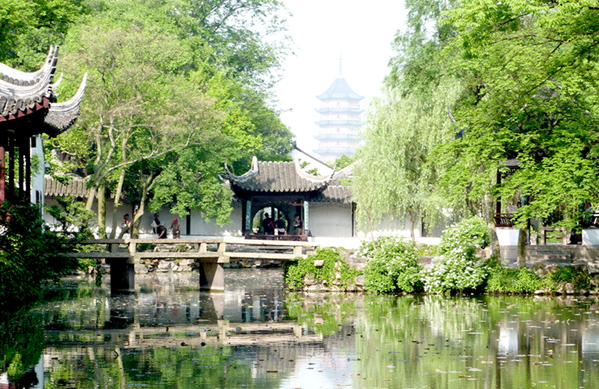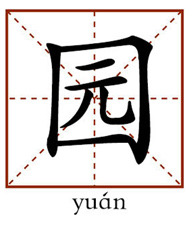Classical Gardens of Suzhou: Harmony between humanity and nature

The North Temple Pagoda outside the Humble Administrator’s Garden is “incorporated” into the composition of the garden. It is an excellent model of the principle of “Borrowed Scenery” in landscape theory of China. ( WU NAN, WANG GUANGLU)

Yuan usually refers to an area of land used to grow plants or for public recreation activities, such as a garden or a park. In ancient China, Yuan also referred to the royal mausoleum. Inspired by the ancient Chinese landscape paintings, the classical gardens of China are built to be fine and elegant with numerous natural elements.
The Classical Gardens of Suzhou date back to the Spring and Autumn Period (770-476 BCE). They developed between the Tang and Song dynasties and thrived during the Ming and Qing dynasties. While the gardens in the Jiangnan area all captivate the nation, those of Suzhou stand out in particular, becoming an exercise in natural harmony. Nine of the best gardens in Suzhou, such as the Humble Administrator’s Garden, the Lingering Garden and the Master of the Nets Garden, have been listed as the UNESCO World Cultural Heritage sites. Inspired by the traditional culture of China, these gardens have something in common. However, each of them has its own unique style.
Humble Administrator’s Garden
As one of the first Classical Gardens of Suzhou to be listed as an item on the UNESCO World Cultural Heritage list, the Humble Administrator’s Garden is the largest in Suzhou, ranking among China’s Top Four Classical Gardens.
Tang Dynasty scholar Lu Guimeng (?-881) used to live there. In the Yuan Dynasty it was used as the garden of the Dahong Temple. During the reign of the Wuzong Emperor (1506-21) of the Ming Dynasty, an official named Wang Xianchen resigned and returned. He rebuilt the garden and named it the Humble Administrator’s Garden after a verse by Pan Yue (247-300), a famous scholar of the Jin Dynasty. In Pan’s prose, An Idle Life, he wrote “I irrigate my garden and grow vegetables...such a life suits a humble official like me well.”
Excluding the residential area, the Humble Administrator’s Garden consists of three major sections. The eastern garden is composed of low hills, castles surrounded by bamboo groves and winding water. The central garden is mainly covered with water, ringed by different buildings in picturesque disorder. The western garden is distinctive for its delicate terraces and towers, rising-and-falling covered paths together with their reflections over the surface of an “L” shaped pond.
It is the central garden, especially the three islands within it, that captures most of the essence of the Humble Administrator’s Garden. Influenced by the landscape style of the Ming Dynasty, the mountains of the central garden consist of soil with stones scattered over the slopes and the foot. Such a design creates a spatial composition with a sense of cleanliness and sparseness, said Cheng Hongfu, the deputy director of the Humble Administrator’s Garden Management Office.
The Pavilion of the Leaning against Rainbow is named after a work of Cheng Ju (1078-1144), a poet of the Northern Song Dynasty (960-1127), who compared the causeway to a rainbow. In contrast to normal square pavilions, this pavilion is located in a Fulang (a covered path with a wall in the middle, separating it into two parallel paths). This pavilion is a designated vantage point for a view of the North Temple Pagoda outside the garden. The garden is designed to allow the outer pagoda to be seen, together with the pond and the bridge inside, creating a specially designed view for visitors to glimpse from the limited spaces available. This design follows the concept of borrowing neighboring scenery, according to which unpleasant scenes could be covered and the beautiful ones could be “borrowed” for the garden, Cheng said.
Behind the Malus Spring Castle, there is a small pond. The northern wall of Malus Spring Castle is built on the crossbeam hanging over the pond. At the bottom of the wall, stones are piled in imitation of natural caverns, creating a visual impact with water flowing out of the pond into the “caverns”. In this way, the space over the tiny pond seems to be greatly extended.
Within the pond of the central garden, three islands recreate the scenery of Penglai, the fairy islands for the immortals of Chinese mythology. Rocks lie at different heights and positions to look like mountains on the islands.
The shape of the Humble Administrator’s Garden is long and narrow with only 50 meters from the north to the south as the crow flies. However, through the meticulous arrangement of rocks, buildings, islands and water, the garden appears to be much larger than it actually is. In other words, the Humble Administrator’s Garden has created a big world within its limited space.
Lingering Garden
The Lingering Garden (Liuyuan in pinyin), which was first built in 1593 during the reign of the Wanli Emperor (1563-1620) of the Ming Dynasty, has changed owners three times. Inspired by the color of bamboo and water inside the garden, the second owner, Liu Shu, an official of the Qing Dynasty, named it Cold Green Village. The garden also acquired the nickname “Liuyuan” from the owner’s surname. In 1873, the garden was renamed “Liuyuan” with the same pronunciation but different characters which meant “lingering between heaven and earth” by its third owner Sheng Kang (1814-1902), another Qing official. Since then, the garden has been known as the Lingering Garden.
The Lingering Garden is one of the largest Classical Gardens of Suzhou, next to the Humble Administrator’s Garden. It is divided into four sections with different themes. The central garden features the scenery of mountains and rivers, revealing the essence of the garden. It also has a longer history than the other three. The western garden conveys a wild charm by imitating forests while the eastern garden highlights traditional architecture. The northern garden used to showcase rural scenery before it was rebuilt as a garden of penjing, a kind of potted landscape with miniature trees and rocks.
Within the fine central garden, the scenes keep changing as the seasons change. One could appreciate the budding willows and wistarias around the Green Shade Pavilion in early spring, then enjoy a pool of lotus flowers on the Lotus Terrace during summer. The Osmanthus Fragrans Pavilion at the peak of the rockery is filled with osmanthus scents in autumn while the red Wintersweet flowers make the Passable Pavilion a wonderful attraction in winter, said Yuan Wenyi, a staff member at the Lingering Garden.
According to Yuan’s introduction, the names of the pavilions indicates the tastes and interests of the owners. For instance, the name of the Osmanthus Fragrans Pavilion is an allusion to the story of Huang Tingjian (1045-1105), a Chinese artist, scholar and poet of the Song Dynasty, and his teacher the Zen Master Huitang. The story indicates that the Buddhist thought, although as invisible as the scents of the osmanthus flowers, could be understood with sincerity. Similarly, the two-story Pellucid Tower is named after a verse from the Commentary on the Water Classic, a work on the ancient geography of China compiled by Li Daoyuan (472-527) during the Northern Wei Dynasty. This tower is built by water with an elegant shape.
Near the Pellucid Tower is the Hanbi Mountain Villa with wide windows on both the northern and the southern wall. In summer, the villa is a good place to enjoy the blooming lotus flowers as well as the cool breeze through the windows. That is why the villa is also called the Lotus Hall, Yuan said.
(edited by REN GUANHONG)

 PRINT
PRINT CLOSE
CLOSE